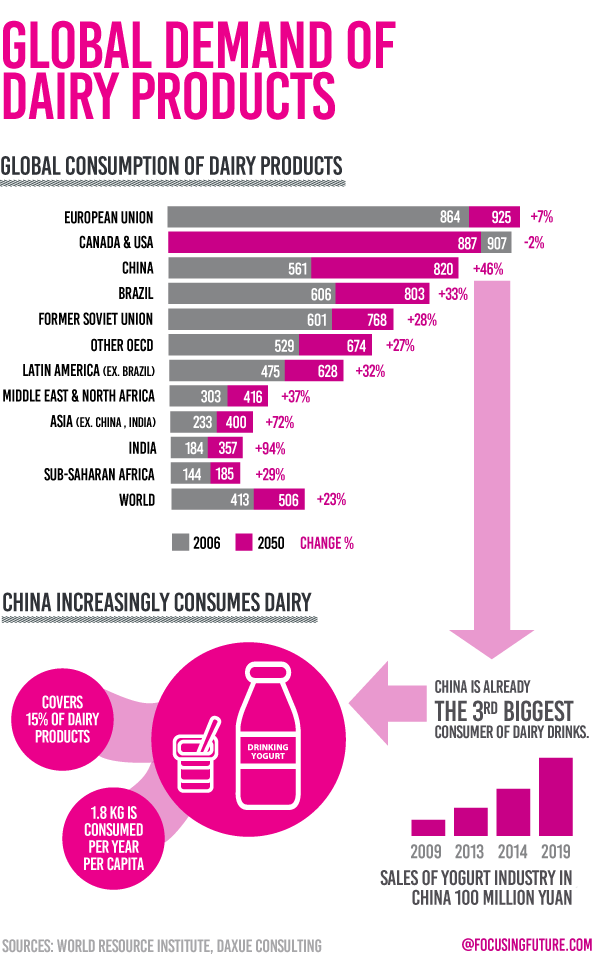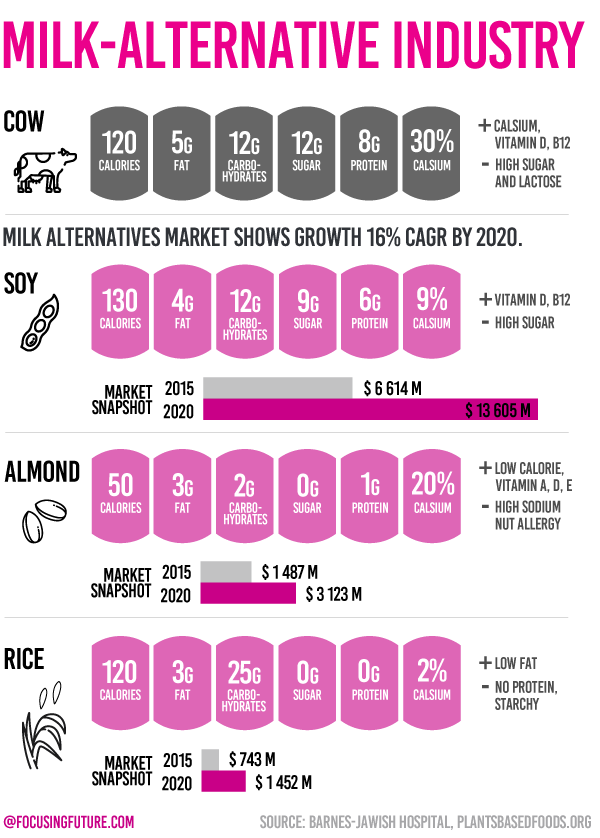![]() 7 minute read
7 minute read
The dairy industry is winning over the consumer market by offering products that suit evolving lifestyles and priorities of the new generation. In the next couple of years, product lines will be lengthened, milk-alternative supply increase, and new Asian markets will be conquered. Integrating sustainable methods in both production and marketing lead to an increased investor interest and indicates R[&]D spendings growth in the industry.
Consumer-driven
dairy Industry
Deloitte expects the demand for its products to increase by 2.5% per annum to 2020 due to consumer behavior changes. Besides seeking for better taste, the buyer is making informed decisions on other ‘product plus’ factors. In the 2015 survey titled ‘Deloitte Food, Value Equation Survey’, 42% of the respondents agreed that their dairy consumption and the choice was based on more evolving drivers such as Health [&] Wellness, safety, social impact, experience, and transparency. Those factors contribute in the new responsibility in the industries management, production, logistics, and marketing. There are new messages that have to be communicated to customers.

Moreover, the popularity of milk products spreads to new locations. According to the Institute for Agriculture Trade Policy, China’s demand for milk is set to grow 38% by 2038. Although dairy is rarely used in local cuisine, the young generation growing increasingly fond of western diets and favor flavored milk. This, in turn, has triggered market research and interest on new forms of products that could potentially appeal this generation.
Dairy
Innovation Centres
The future of dairy is a vivid choice that will volumize the market. One of the hallmarks of this approach is the establishment of a ‘global innovation centre’ by Arla in Aarhus, Denmark. Here, experiments on ‘fizzy milks’ and ‘yogurt jerkies’ are being done. The center is working in collaboration with universities, dairy farmers and consumers to make products that can sustain the rapidly changing attitudes towards the products. A similar experiment is Kellog’s cereal milk bars that are directed towards the consumers who want breakfast on the go. Such products are based on the trend captured by Kantar research company whereby people are preferring snacking throughout the day than eating breakfasts. Such priorities are also affecting how dairy products are processed. Rachel Hurn-Maloney, founder of Alt-Milk, a fresh cold-pressed almond milk, insists that their clients prefer fresh milk to highly processed products. ‘We have seen that most of our customers are lifetime customers, who tell their friends, and don’t go back to long (shelf) life’. Pop and Bottle, and Three Trees, both key players in the US milk alternate market, too have stopped processing their milk in High Pressure to extend shelf life.
Drinking milk
at the expense
of the environment?
An important consumer trend is decreasing the carbon footprint of dairy products. With time, people are becoming more aware of the environmental costs of their uses and hence change behavior accordingly. A recent study done by Rui Zhao of Southwest Jiaotong University illustrates that consumers start preferring milk packaging with carbon labeling, even changing their longtime preferred brands. The same attitude has now translated in the supply side where companies are making products that are more environmentally friendly. Dr. Charles E. Sizer, founder and CEO of Dairyvative Technologies, is one such example. The company has developed the SevenX technology that allows pasteurized milk to be concentrated to one-seventh of their original size. They have since received a $2.5 million investment fund and have signed strategic partnerships with Berkshire’s Cornelius, Inc. Dr. Sizer, insists that it is very environmentally friendly. Comparing the 2.05 kilos of carbon emission for one liter of conventional milk, he boasts a reduction of 20-30% using his methods and ‘by locating in close proximity to the dairy, we can reduce even further.’ Along with other industries, the dairy one is undergoing the changes in accordance with the new regulations directed to climate change issue.
The free-form
invasion
The ‘free-from’ movement in food has been one of the most distinguishable trends in 2017. According to Orion Research, the market is forecasted to be worth $28.8 billion by 2023. The dairy industry introduces alternatives to conventional milk to cater to the needs of lactose-free demands. The global dairy alternative market which is already worth $9.8 billion is forecasted a growth CAGR of 12.4% till 2025. Of the many substitute milk products in the market, pea based products made by Ripple seem to be the most popular. Boasting 8 times more protein than almond milk, the company has managed to get $44 million funding, $30 millions of which comes from Google. Since their launch in April 2016, Ripple has sold 2.5 million products at a revenue of $20 million. Besides the improved protein intake, the products are very environmentally friendly. According to the founders Adam Lowry and Neil Renninger, their current sales add up to a decrease of 7 million fewer pounds of CO2 emissions.

Another similar case is the efforts by the Swedish drinks company Oatly, to train and equip farmers to make milk out of oats in order to cut climatic impact. Those who have shifted to produce milk are shown to produce double the calorie products while halving the climate impact on each of them. Producers working under the initiative were responsible for 28 million tons of milk in 2016 and hope to increase production to 100 million by 2020.
Innovations in an alternate, free-from products are not limited to milk alone. For example, All in Foods, a Brittany based company, has come up with the BioVeg Cheese free from soy, gluten, palm oil, lactose, and GMO. The product line offers an alternate option to users who have special dietary preferences or are more environmentally conscious. The company has had contracts with some of the largest retailers in France. It is now in the process of getting an organic certification, making it a true alternative to commercially available dairy cheeses.
Milk-printing
In Wageningen University in the Netherlands, researchers are 3D printing different ingredients in combination with sodium caseinate to fashion them into dairy products. Dr. Maarten Schutyser, the professor at the helm of the project finds great potential in printing food: ‘With 3D printing you can you can tailor your product or food to individual needs…printing it on demand’.
The industry is a subject for technological innovations and elimination of living organisms in the production process. Perfect Day, which has raised over $4 million from investors, seeks to make cow milk without cows. They do this by 3D printing cow’s DNA sequence in yeast, leading to the fermentation of sugar and production of A2 milk protein. The protein is lactose-free and is a lot easier to break down in the digestive system. According to Ryan Pandya, co-founder of Perfect Day, the product will be exactly like conventional milk and ‘(the) body cannot tell the difference because it’s the same in every meaningful way’. Climbing on to the bandwagon of sustainability, the company heavily markets their approach as good for the environment due to the obvious independence from cow rearing. The company aims to produce other dairy products using their technology and seek a greater share in the future dairy industry.




